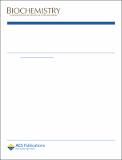Por favor, use este identificador para citar o enlazar a este item:
http://hdl.handle.net/10261/11083COMPARTIR / EXPORTAR:
 SHARE SHARE
 CORE
BASE CORE
BASE
|
|
| Visualizar otros formatos: MARC | Dublin Core | RDF | ORE | MODS | METS | DIDL | DATACITE | |

| Título: | Copper(II) inhibition of electron transfer through photosystem II studied by EPR spectroscopy. |
Autor: | Jegerschöld, Caroline; Arellano, Juan B. CSIC ORCID ; Schröder, Wolfgang P.; van Kan, Paul J. M.; Barón Ayala, Matilde CSIC ORCID; Styring, Stenbjörn | Palabras clave: | Copper Photosystem II Electron spin resonance |
Fecha de publicación: | oct-1995 | Editor: | American Chemical Society | Citación: | Biochemistry (2005) 34 : 12747-54 | Resumen: | EPR spectroscopy was applied to investigate the inhibition of electron transport in photosystem II by Cu2+ ions. Our results show that Cu2+ has inhibitory effects on both the donor and the acceptor side of photosystem II. In the presence of Cu2+, neither EPR signal IIvery fast nor signal IIfast, which both reflect oxidation of tyrosinez, could be induced by illumination. This shows that Cu2+ inhibits electron transfer from tyrosinez to the oxidized primary donor P680+. Instead of tyrosinez oxidation, illumination results in the formation of a new radical with g = 2.0028 +/- 0.0002 and a spectral width of 9.5 +/- 0.3 G. At room temperature, this radical amounts to one spin per PS II reaction center. Incubation of photosystem II membranes with cupric ions also results in release of the 16 kDa extrinsic subunit and conversion of cytochrome b559 to the low-potential form. On the acceptor side, QA can still be reduced by illumination or chemical reduction with dithionite. However, incubation with Cu2+ results in loss of the normal EPR signal from QA- which is coupled to the non-heme Fe2+ on the acceptor side (the QA(-)-Fe2+ EPR signal). Instead, reduction of QA results in the formation of a free radical spectrum which is 9.5 G wide and centered at g = 2.0044. This signal is attributed to QA- which is magnetically decoupled from the non-heme iron. This suggests that Cu2+ displaces the Fe2+ or severely alters its binding properties. The inhibition of tyrosinez is reversible upon removal of the copper ions with EDTA while the modification of QA was found to be irreversible. | Versión del editor: | http://pubs.acs.org/doi/abs/10.1021/bi00039a034 | URI: | http://hdl.handle.net/10261/11083 | DOI: | 10.1021/bi00039a034 |
| Aparece en las colecciones: | (IRNASA) Artículos |
Ficheros en este ítem:
| Fichero | Descripción | Tamaño | Formato | |
|---|---|---|---|---|
| Jegerschöld et al 1995.pdf | 174,68 kB | Adobe PDF |  Visualizar/Abrir |
CORE Recommender
SCOPUSTM
Citations
83
checked on 21-abr-2024
WEB OF SCIENCETM
Citations
77
checked on 29-feb-2024
Page view(s)
387
checked on 23-abr-2024
Download(s)
352
checked on 23-abr-2024
Google ScholarTM
Check
Altmetric
Altmetric
NOTA: Los ítems de Digital.CSIC están protegidos por copyright, con todos los derechos reservados, a menos que se indique lo contrario.
